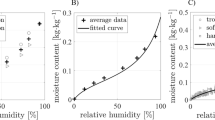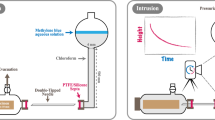Abstract
For in situ timber structure applications, heat and mass transfer are strongly dependent on temperature. This work focuses on a parametrical modeling to evaluate and quantify temperature effect at each stage. The model is classically based on a coupling between Fourier's law, which establishes the temporal and spatial distribution of temperature, and Fick's law dealing specifically with the water field distribution. Several hypotheses are proposed and discussed in this work regarding thermal coupling. In particular, it is shown how to integrate temperature into a permeability correction. An interaction between temperature and the sorption isotherm is also proposed herein. The model incorporates partial adsorption and desorption isotherms. Implementation in a finite element software allows highlighting the various couplings, in comparison with more standard calculus approaches.













Similar content being viewed by others
Abbreviations
- A, B, β :
-
Fitting parameters of water capacity, dimensionless
- A a :
-
Fitting parameter of ∆Hs in adsorption, in J kg−1
- A d :
-
Fitting parameter of ∆Hs in desorption, in J kg−1
- C W :
-
Heat capacity of water, in J kg−1 K−1
- C h :
-
Homogenized heat capacity, in J kg−1 K−1
- C anh :
-
Dry heat capacity, in J kg−1 K−1
- C pv :
-
Heat capacity of vapor, in J kg−1 K−1
- D T :
-
Heat transfer tensor, in m2 s−1
- D W :
-
Moisture transfer tensor, in m2 s−1
- D WT :
-
Hygrothermal coupling tensor (Soret’s effect), in m2 s−1
- D TW :
-
Thermo-hydric coupling tensor, in m2 s−1
- E a :
-
Activation energy, in J kg−1
- h T :
-
Convective heat transfer coefficient, in W m−2 K−1
- h W :
-
Convective moisture transfer coefficient, in s m−1
- H s :
-
Sorption latent heat, in kJ kg−1
- ∆Hs :
-
Latent heat of sorption of bound water, in kJ kg−1
- L :
-
Latent heat of free water vaporization, in kJ kg−1
- m W :
-
Wet mass, in kg
- m anh :
-
Dry mass, in kg
- RH:
-
Relative humidity, dimensionless
- ∆RH:
-
Incremental variation of relative humidity, dimensionless
- RHamb :
-
Ambient air relative humidity, dimensionless
- RHsurf :
-
Equivalent surface relative humidity, dimensionless
- p v :
-
Vapor pressure, in Pa
- p vs :
-
Saturated vapor pressure, in Pa
- R :
-
Ideal gas law constant, in J mol−1 K−1
- T :
-
Temperature field, in K
- T amb :
-
Ambient air temperature, in K
- T surf :
-
Surface temperature, in K
- W :
-
Moisture content field, dimensionless
- wi, wi+1 :
-
Incremental moisture content field, dimensionless
- w s :
-
Moisture content at the fiber saturation point, dimensionless
- w a :
-
Moisture content field at the end of adsorption, dimensionless
- w d :
-
Moisture content field at the end of desorption, dimensionless
- δ:
-
Vapor permeability, in kg s−1 m−1 Pa−1
- δ* :
-
Apparent vapor permeability, in kg s−1 m−1 Pa−1
- δo :
-
Vapor permeability fitting parameter, in kg s−1 m−1 Pa−1
- λ (w):
-
Thermal conductivity of the wet material, in W m−1 K−1
- ξ:
-
Water capacity, dimensionless
- ξab :
-
Water envelope capacity in adsorption, dimensionless
- ξdb :
-
Water envelope capacity in desorption, dimensionless
- ξa :
-
Partial water capacity in adsorption, dimensionless
- ξd :
-
Partial water capacity in desorption, dimensionless
- ρ h :
-
Wet density, in kg m−3
- ρ anh :
-
Dry density, in kg m−3
- ϕa, αa :
-
Thermodynamic parameters for adsorption, dimensionless
- ϕd, αd :
-
Thermodynamic parameters for desorption, dimensionless
References
AFNOR (2010). NF EN 1995-1-1/NA. Eurocode 5 : Design of timber structures—Part 1–1: General—Common rules and rules for buildings—National annex to NF EN 1995-1-1:2008—General—Common rules and rules for buildings
Brunauer S, Emmett PH, Teller E (1938) Adsorption of gases in multimolecular layers. J Am Chem Soc 60:309–319
Chen M, Coasne B, Guyer R, Derome D, Carmeliet J (2018) Role of hydrogen bonding in hysteresis observed in sorption-induced swelling of soft nanoporous polymers. Nat Commun 9:3507. https://doi.org/10.1038/s41467-018-05897-9
Choong ET (1963) Movement of moisture through a softwood in the hygroscopic range. For Prod J 13(11):489–498
Dent RW (1980) A sorption theory for gas mixtures. Polym Eng Sci 20:286–289
Frandsen HL (2007) Selected constitutive models for simulating the hygromechanical response of wood. DCE thesis, Department of Civil Engineering, Aalborg University, Denmark.
Hartley ID (1993) Analysis of the wood sorption isotherm using clustering theory. Holzforschung 47:163–167
Kulasinski K (2015) Physical and mechanical aspects of moisture adsorption in wood biopolymers investigated with atomisitic simulations. PhD Thesis, ETH Zurich, Switzerland.
Künzel H (1995) Simultaneous heat and moisture transport in building components: One-and two dimensional calculation using simple parameters (Fraunhofer IRB Verlag). PhD Thesis, Fraunhofer Institute of Building Physics, Germany.
Li X, Zhang B, Li W, Li Y (2006) Nonisothermal moisture movement in wood. Front For China 1:348–352
Luikov AV, Mikhailov YA (1965) Theory of energy and mass transfer. Pergamon Press, Oxford
Merakeb S (2006) Couplage hygromécanique dans le processus de diffusion dans le bois. PhD thesis, University of Limoges
Merakeb S, Dubois F, Petit C (2009) Modeling of the sorption hysteresis for wood. Wood Sci Technol 43:575–589
Nelson RM (1986) Diffusion of bound water in wood-part 3-A model for nonisothermal diffusion. Wood Sci Technol 20:309–328
Nelson RM (1991) Heats of transfer and activation energy for bound water diffusion in wood. Wood Sci Technol 25:193–202
Pedersen CR (1990) Combined heat and moisture transfer in building constructions. Thermal Insulation Laboratory Technical University of Denmark, Lyngby
Perré P, May BK (2001) A numerical drying model that accounts for the coupling between transfers and solid mechanics. Case of highly deformable products. Dry Technol 19:1629–1643
Philip JR, Vries DA (1957) Moisture movement in porous materials under temperature gradients. Trans Am Geophys Union 38:222–232
Rawat SPS (1996) Enthalpy-entropy compensation during sorption of water in wood. J Appl Polym Sci 60:787–790
Rosen HN (1976) Exponential dependency of moisture diffusion coefficient. Wood Sci 8:174–179
Siau JF (1971) Flow in wood. Syracuse University Press, New York
Siau JF, Jin Z (1985) Nonisothermal moisture diffusion experiments analyzed by four alternative equations. Wood Sci Technol 19:151–157
Skaar C (1988) Wood water relations. Springer-Verlag, Berlin
Stamm AJ (1959) Bound water diffusion into wood in the fiber direction. For Prod J 9(1):27–32
Stamm AJ (1964) Wood and cellulose science. Ronald Press Co., New York
Varnier M, Sauvat N, Montero C, Dubois F, Gril J (2018) Adaptation of Eurocode 5 standard to French hardwoods—proposal of new hygroscopic equilibrium charts. In: 5th INTER meeting Tallinn, Estonia
Zhang C, Coasne B, Guyer R, Derome D, Carmeliet J (2020) Moisture-induced crossover in the thermodynamic and mechanical response of hydrophilic biopolymer. Cellulose 27:89–99
Acknowledgements
This work has been funded by the French National Research Agency (ANR) through EFEUR5 project (ANR‐15‐CE08‐0027) concerning Structural behavior of French Hardwood for better optimization with Eurocode 5. The authors would like to express their appreciation towards the ANR financial support.
Author information
Authors and Affiliations
Corresponding author
Additional information
Publisher's Note
Springer Nature remains neutral with regard to jurisdictional claims in published maps and institutional affiliations.
Rights and permissions
About this article
Cite this article
Varnier, M., Sauvat, N., Ulmet, L. et al. Influence of temperature in a mass transfer simulation: application to wood. Wood Sci Technol 54, 943–962 (2020). https://doi.org/10.1007/s00226-020-01197-y
Received:
Published:
Issue Date:
DOI: https://doi.org/10.1007/s00226-020-01197-y




